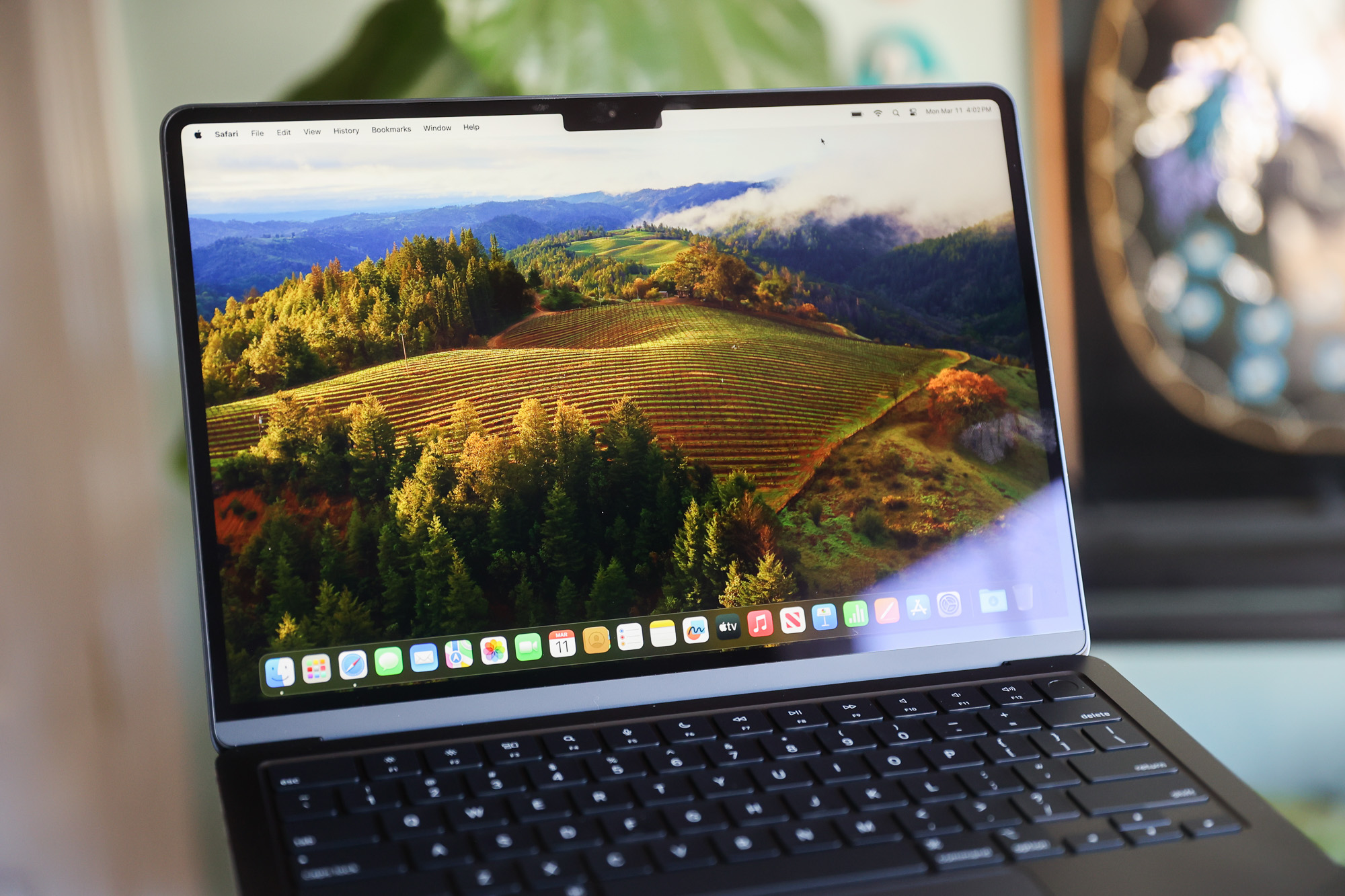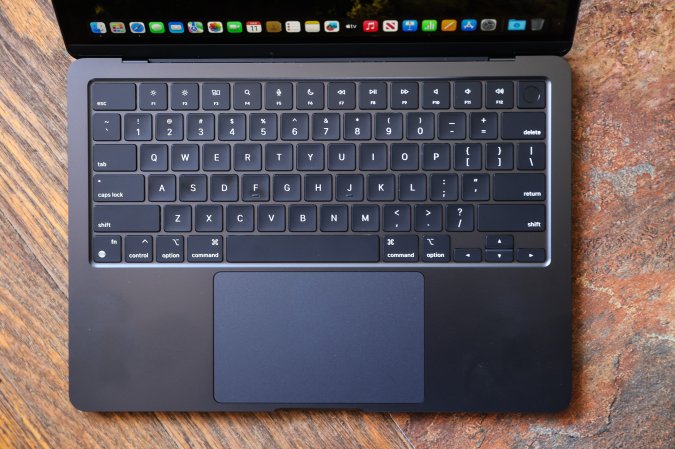

We may earn revenue from the products available on this page and participate in affiliate programs. Learn more ›
I took the MacBook Air M3 off the charger at around 3 p.m. on Friday. At 2.7 pounds, it’s light and compact enough to finish off the week’s work from the couch. Throughout the weekend, I dumped a bunch of raw files from a Canon R6 mirrorless camera to the MBA’s 512GB SSD. I watched a bunch of streamed episodes of Seinfeld on Netflix while I cleaned up around the house. I even used it to troubleshoot my parents’ Wi-Fi connection when they couldn’t get online. Before I knew it, Monday morning had arrived, and I still hadn’t plugged the MacBook Air back in. The battery indicator still said I had 21 percent of my juice left. This is how I want life with a laptop to go and I’m frankly not surprised that Apple’s latest ultra-portable delivers it. The 13-inch MacBook Air M3 is the predictable choice as the best laptop for most people, but it’s also the right choice, at least according to my experience so far.
What’s new in the 13-inch MacBook Air M3?
Apple switched up its MacBook Air design with the M2 generation, which debuted last year. It ditched the iconic (if a little dated) wedge-shaped design for a flatter form factor similar to the MacBook Pro computers. The M3 MacBook Air sticks to that new design, weighing in at 2.7 pounds and standing just 0.44 inches tall. In that slim strip, you get two USB-C (Thunderbolt 3) ports and a MagSafe 3 charging port on one side, and a 3.5mm headphone jack with high-impedance headphone support on the other. It’s 11.97 inches wide and 8.46 inches long and is available in Silver, Starlight, Space Gray, or Midnight (shown here). Ultimately, it feels like a MacBook Air, so no real surprises there.
Welcome Wi-Fi 6E
The upgrades are somewhat specific but useful for some people. The M3 now offers Wi-Fi 6E connectivity, an upgrade from the M2’s Wi-Fi 6. Of course, you’ll need a Wi-Fi 6E router in order to take any real advantage of any performance boost.
Better external monitor support
Close the MacBook Air’s lid, and it can fully support a pair of high-res monitors. The M2 model can only support a single external display. If you spend a lot of time sitting at a desk, which I unfortunately do, this might excite you. It’s slightly odd that the lid has to be closed, but it’s undeniably nicer to have two big matching external displays rather than one huge screen and the MBA’s tiny screen next to each other on the desk.
Performance upgrades
The real meat-and-potatoes upgrades come in the form of the computing hardware. This machine employs the Apple M3 chip, which promises a tangible speed upgrade compared to previous versions. Apple promises relatively modest overall performance upgrades for the CPU and GPU compared to the M2. Quick benchmarking tests suggest as much. We’re not publishing the benchmarks here; they’re simply meant to give us a reference. Plenty of great sites out there create controlled benchmark tests to help you ensure that you get the laptop that makes the biggest numbers on the testing graphs.
The new GPU architecture represents one of the bigger changes in overall performance. This is slightly conflicting for me because I’ll obviously always take the extra performance bump. Still, if you regularly play intensive games or do heavy creative work like video editing or music production, you’re almost certainly better off spending some extra money and upgrading to the MacBook Pro to get the extra performance enabled by the more robust cooling.

Which MacBook should you buy?
Since there are no real surprises here in terms of everyday usage, here are some common comparisons you’re likely to make if you’re shopping for a MacBook:
MacBook Air M2 vs. MacBook Air M3
If you’re already using an M2 MacBook Air, then you don’t really have much incentive to move up to the newest model. The Wi-Fi 6E is nice, and the performance upgrades aren’t totally intangible, but it’s rarely necessary to upgrade MacBooks with every generation. Run the M2 until it doesn’t do what you need, then move on to the next version. If your M2 is seriously lagging on you because you’re doing resource-intensive work, then you’re probably best served moving up to a MacBook Pro and skipping the Air series in general.
MacBook Air M1 vs. MacBook Air M3
This is a different story. The M1 MacBook Air is still a great little machine for most people, but it’s getting long in the tooth. Really think about whether you need the extra performance. We’ve seen the M1 machines go for $749 in recent months, which is a full $350 cheaper than the new M3 (when comparing base models). If your daily activities don’t get much more intense than email and web surfing, the M1 still may have plenty of power. That said, I like the M3 form factor much more, and that M3 chip will stay relevant for years longer than the M1 at this point.
MacBook Air M3 vs. MacBook Pro 14-inch and 16-inch
It’s nice to think of yourself as a “pro,” but not everyone needs to spend the money jumping up to the MBP laptops series. The cheapest 14-inch MacBook Pro comes with a standard M3 chip and adds a full $500 to the base price. That’s a considerable jump, but it’s worth the extra cost if you’re regularly editing video, churning through huge photo files, or doing other greedy tasks. That extra cost also comes with a bigger, heavier machine, so be realistic about your needs. Editing the occasional Reel in Final Cut isn’t reason enough to splurge unless you really want it.
What MacBook Air M3 configuration should you buy?
While I’m a big fan of Apple silicon, I think it’s a slight miss for the company to set 8GB as the floor for shared memory. The move up to 16GB also comes with an extra 256GB of built-in storage (for a total of 512GB) and two extra GPU cores for a total price of $1,499. That’s $400 more than the base model, but it will keep your machine relevant and capable for longer (and save you from buying an external hard drive, at least for a bit). A well-treated MacBook Air can last five years or more. Those upgrades now will have a big impact on how well it ages. Remember, the M-series chips are basically fully enclosed so you can’t upgrade much later.
All of that said, the base M3 MacBook Air is likely just fine for most people right now. If you’re not planning on running this machine into the 2030s and primarily using your computer for school or business, you can save the upgrade money without feeling like you’re missing out on much.

So, who should buy the MacBook Air M3?
Like I said above, I really do believe the MacBook Air M3 is the best laptop for most people at the moment. It’s beautifully designed, very portable, and extremely quick at every task we tried. The base model does feel a smidge underpowered for the price, but we’re used to paying a little extra when it comes to Apple. Overall, this is one of the best laptops I’ve ever used. I assume I’ll be saying the same thing again this time next year when the M4 version comes out. That’s OK with me. I don’t really like surprises anyway.

